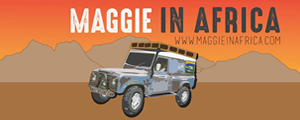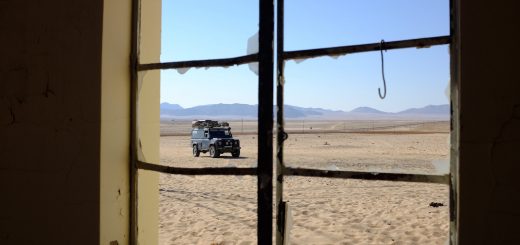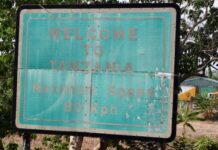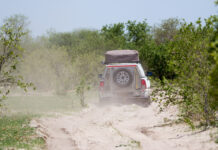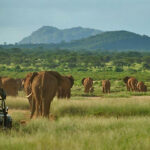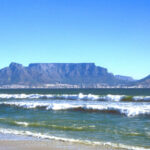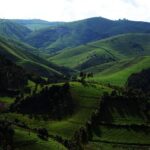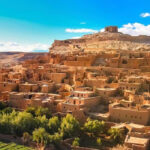Heading north from Fish River Canyon is one of southern Namibia’s main tourist attractions: the desert ghost town of Kolmanskop.
Kolmanskop: a mining town swallowed by desert
A few km inland from the coastal town of Luderitz is the former diamond mining town, abandoned 50 years ago to be swallowed by the Namib desert.
kolmanskop_ghost_town_namibia_house
House being eaten by sand dunes, Kolmanskop
In the early 1900s, Kolmanskop was a vibrant town full of German and Namibian workers. Still on the site are the houses and shops built in traditional German architecture that has now been reclaimed by desert sands.
Kolmanskop-ghost-town-namibia
View of Kolmanskop from an abandoned house
The creepiness of the town was definitely offset by the number of tourists visiting. In the 1980s, mining company De Beers partially restored the town to open it to tourists. When we visited there were at least 40 others!
house-kolmanskop-desert-ghost-town-namibia
House being swallowed by sand dunes, Kolmanskop
Although it’s located in the Sperrgebiet (forbidden diamond mining territory, best pronounced by shouting in a fake German accent), anyone can purchase a permit for N$75 per person from NamDeb, either at the gate or through an agency in Luderitz. The entrance fee also includes a tour of the town, which is interesting but takes away some of the town’s mystery.
staircase-kolmanskop-ghost-town-desert-namibia
Staircase in abandoned house in Kolmanskop, Namibia
The long, lonely road to Kolmanskop
Probably more creepy than the town itself is the long and largely empty road between Aus and Ludertiz, which passes through a beautiful, but barren desert landscape.
Road-Aus-Luderitz-Namibia
Sand dunes creep over the road to Luderitz, Namibia
There are, however, a number of awesome things to visit on the drive. Our favourite stop was to see the wild horses of Aus (pictured below).
wild-horses-aus-water-hole
Wild horses of Aus, view from the watering hole
No one knows exactly why there are horses in the Namib Desert.They could have been brought over by the Germans during wartime, or washed up after a shipwreck. We asked locals and got several different explanations! Either way, spotting them definitely makes the long drive from Aus to Luderitz more interesting!
Tsamma melons, eaten by Oryx in the Namib desert
Tsamma melons, eaten by Oryx in the Namib desert
The road to Luderitz also follows a rail line, which is apparently still operational. We had a fun time checking out the abandoned and amazingly photogenic train stations in the middle of the desert.
abandoned-train-station-namibia-aus-luderitz
Abandoned train station on the road to Luderitz, Namibia
Staying in and exploring Luderitz
The majority of people visiting Kolmaskop do so on the way to Ludertiz, the coastal town purchased by the Germans from the local Nama people in 1883. The uniqueness of Luderitz has to be its traditional German architecture located in a harsh desert landscape.
dias-point-ludertiz
View from Dias Point, Luderitz
We had a fun day driving to the nearby Dias point, where explorer Bartolomeu Dias erected a cross, and exploring the surrounding bays where inhospitable desert meets the rough Atlantic ocean. These areas are just south of Luderitz, but outside of the forbidden area, and are best traversed in a 4×4. Occasionally, visitors can spot seals and penguins, but sadly we only saw a whole load of seagulls and flamingos!
We definitely recommend camping at Shark Island, with sites right on the coast. Although it’s very windy, it’s definitely a memorable experience, especially if you can book the self-catering apartment in the old lighthouse.
